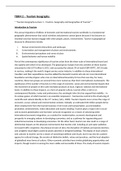Summary
Summary Tourism Geography 225 Summaries
- Course
- Institution
- Book
A well integrated and summarized combination of textbooks material, lecture slides and my own personal understanding of all the information as well as important in-text case studies from the textbook that helped me during tests and exams. Perfect study notes.
[Show more]









